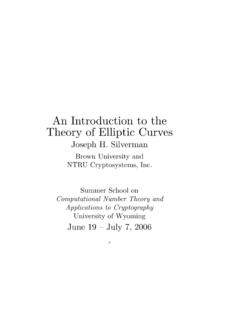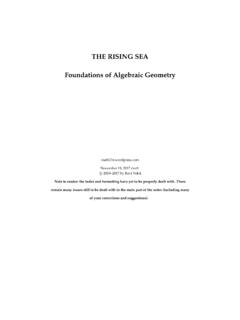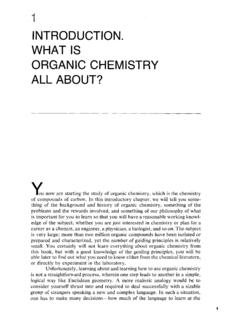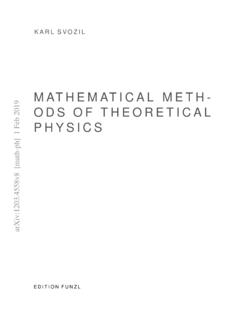Transcription of Hyperbolic Geometry - math.brown.edu
1 Flavors of Geometry MSRI Publications Volume 31, 1997. Hyperbolic Geometry JAMES W. CANNON, WILLIAM J. FLOYD, RICHARD KENYON, AND WALTER R. PARRY. Contents 1. Introduction 59. 2. The Origins of Hyperbolic Geometry 60. 3. Why Call it Hyperbolic Geometry ? 63. 4. Understanding the One-Dimensional Case 65. 5. Generalizing to Higher Dimensions 67. 6. Rudiments of Riemannian Geometry 68. 7. Five Models of Hyperbolic Space 69. 8. Stereographic Projection 72. 9. Geodesics 77. 10. Isometries and Distances in the Hyperboloid Model 80.
2 11. The Space at Infinity 84. 12. The Geometric Classification of Isometries 84. 13. Curious Facts about Hyperbolic Space 86. 14. The Sixth Model 95. 15. Why Study Hyperbolic Geometry ? 98. 16. When Does a Manifold Have a Hyperbolic Structure? 103. 17. How to Get Analytic Coordinates at Infinity? 106. References 108. Index 110. 1. Introduction Hyperbolic Geometry was created in the first half of the nineteenth century in the midst of attempts to understand Euclid's axiomatic basis for Geometry . It is one type of non-Euclidean Geometry , that is, a Geometry that discards one of Euclid's axioms.
3 Einstein and Minkowski found in non-Euclidean Geometry a This work was supported in part by The Geometry Center, University of Minnesota, an STC. funded by NSF, DOE, and Minnesota Technology, Inc., by the Mathematical Sciences Research Institute, and by NSF research grants. 59. 60 J. W. CANNON, W. J. FLOYD, R. KENYON, AND W. R. PARRY. geometric basis for the understanding of physical time and space. In the early part of the twentieth century every serious student of mathematics and physics studied non-Euclidean Geometry .
4 This has not been true of the mathematicians and physicists of our generation. Nevertheless with the passage of time it has become more and more apparent that the negatively curved geometries, of which Hyperbolic non-Euclidean Geometry is the prototype, are the generic forms of ge- ometry. They have profound applications to the study of complex variables, to the topology of two- and three -dimensional manifolds, to the study of finitely presented infinite groups, to physics, and to other disparate fields of mathemat- ics.
5 A working knowledge of Hyperbolic Geometry has become a prerequisite for workers in these fields. These notes are intended as a relatively quick introduction to Hyperbolic ge- ometry. They review the wonderful history of non-Euclidean Geometry . They give five different analytic models for and several combinatorial approximations to non-Euclidean Geometry by means of which the reader can develop an intu- ition for the behavior of this Geometry . They develop a number of the properties of this Geometry that are particularly important in topology and group theory.
6 They indicate some of the fundamental problems being approached by means of non-Euclidean Geometry in topology and group theory. Volumes have been written on non-Euclidean Geometry , which the reader must consult for more exhaustive information. We recommend [Iversen 1993]. for starters, and [Benedetti and Petronio 1992; Thurston 1997; Ratcliffe 1994]. for more advanced readers. The latter has a particularly comprehensive bibliog- raphy. 2. The Origins of Hyperbolic Geometry Except for Euclid's five fundamental postulates of plane Geometry , which we paraphrase from [Kline 1972], most of the following historical material is taken from Felix Klein's book [1928].
7 Here are Euclid's postulates in contemporary language (compare [Euclid 1926]): 1. Each pair of points can be joined by one and only one straight line segment. 2. Any straight line segment can be indefinitely extended in either direction. 3. There is exactly one circle of any given radius with any given center. 4. All right angles are congruent to one another. 5. If a straight line falling on two straight lines makes the interior angles on the same side less than two right angles, the two straight lines, if extended indefinitely, meet on that side on which the angles are less than two right angles.
8 Of these five postulates, the fifth is by far the most complicated and unnatural. Given the first four, the fifth postulate can easily be seen to be equivalent to the Hyperbolic Geometry 61. following parallel postulate, which explains why the expressions Euclid's fifth postulate and the parallel parallel are often used interchangeably: 50 . Given a line and a point not on it, there is exactly one line going through the given point that is parallel to the given line. For two thousand years mathematicians attempted to deduce the fifth postulate from the four simpler postulates.
9 In each case one reduced the proof of the fifth postulate to the conjunction of the first four postulates with an additional natural postulate that, in fact, proved to be equivalent to the fifth: Proclus (ca. 400 ) used as additional postulate the assumption that the points at constant distance from a given line on one side form a straight line. The Englishman John Wallis (1616 1703) used the assumption that to every triangle there is a similar triangle of each given size. The Italian Girolamo Saccheri (1667 1733) considered quadrilaterals with two base angles equal to a right angle and with vertical sides having equal length and deduced consequences from the (non-Euclidean) possibility that the remaining two angles were not right angles.
10 Johann Heinrich Lambert (1728 1777) proceeded in a similar fashion and wrote an extensive work on the subject, posthumously published in 1786. Go ttingen mathematician Ka stner (1719 1800) directed a thesis of student Klu gel (1739 1812), which considered approximately thirty proof attempts for the parallel postulate. Decisive progress came in the nineteenth century, when mathematicians aban- doned the effort to find a contradiction in the denial of the fifth postulate and instead worked out carefully and completely the consequences of such a denial.








